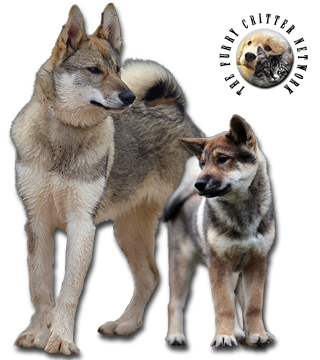Breed Standard
Head: Not heavy. Skull is the shape of an isosceles triangle. Stop not pronounced. Clean muzzle. Tight lips.
Ears: Triangular, carried erect. Mobile. Pointed tips.
Eyes: Not large. Oval. Set obliquely in the skull. Dark color.
Body: Strong. Pronounced withers. Full chest is well let down. Broad, slightly sloped croup. Belly is tucked up. Short, slightly sloped loin. Solid, muscular back.
Tail: Carried in a sickle or curled over the back or the back of the thighs.
Hair: Russo-European and Western Siberian Laikas: Hard, straight, short on the head and ears. Longer on the neck, withers, and shoulders. Feathering on the back of the legs. Full undercoat.- Eastern Siberian Laika: Long, coarse, dense, straight. Male has a mane and collarette. Dense, supple undercoat.
Coat: Russo-European Laika: black, gray, white, pepper and salt, dark with white markings or white with dark markings.- Western Siberian Laika: white, pepper and salt, red and shades of gray; black is permissible.- Eastern Siberian Laika: pepper and salt, white, gray, black, shades of red or brown; spotted or mottled.
Size: Russo-European Laika: dog: 52 to 58 cm (20.5-22.8 in) ; bitch: 50 to 56 cm (19.7-22 in).- Western Siberian Laika: dog: 54 to 60 cm (21-23.5 in) ; bitch: 52 to 58 cm (20.5-22.8 in).- Eastern Siberian Laika: dog: 55 to 63 cm (22-25 in) ; bitch: 53 to 61 cm (21-24 in).
Weight: 20 to 30 kg (44-66 lb).
History
The Laika belongs to the spitz family. There are three varieties. The Russo-European Laika is descended from the hunting Laikas and originated in northern Russia. This variety is now common in the central region of the country. The Western Siberian Laika originated in the northern Urals and is the result of crossing Laikas and hunting dogs. The Eastern Siberian Laika originated in the large forests in the east. It is the result of crosses of various Laikas. This variety is used for hunting large northern game. This breed is famous because a Laika became the "first living ambassador from Earth" when he was hurtled into space aboard Sputnik II on November 3, 1957.
Behavior
The West Siberian Laika is primarily a hunting dog. Anyone who decides on a puppy of this breed should expect a full package of traits of a typical hunting Spitz. It is an emotional dog, very observant to the habits of its master, his mood and often can foresee his intentions. It does not hesitate to express its strong feelings by barking and other noises. The West Siberian Laika is a poor kennel dog. If the dog is left alone, locked up in a small backyard or in a pen, some dogs develop a habit of barking, seemingly without a purpose. Permanently penned or fenced West Siberian Laikas attempt to dig under the fence or climb over it. Some dogs not trained to stay penned, try to bite the wires and thereby they damage their teeth. Once freed or turned loose, such a dog will be hard to control. It will run too far, chase other animals and likely get into trouble. West Siberian Laikas that are kept well exercised, busy with hunting and contacts with other dogs, animals and people, are content, obedient and never bark without a reason. Therefore, to make a happy dog and its owner, the right conditions of the environment for hunting plus time dedicated to the dog must be met.
All West Siberian Laikas are naturally protective against wild animals, especially predators, and some dogs are protective against strangers acting suspicious or violent. A West Siberian Laika will make a good companion dog for a hiking trip. However, its extraordinary interest in wildlife demands special attention because the dog may tree some animals and stay far behind for some time. The West Siberian Laika is a great psycho-therapy dog for able bodied active people, who are not lazy to walk a lot and hunt. He needs regular free exercising between hunting seasons. This lively, alert dog has a strong, stable personality. He barks a lot (laika means "barker"). The Laika is very devoted to his owner and suspicious of strangers. Firm training is a must.
This dog is not suited for life as a house dog. He needs space and considerable exercise.
Function
Hunting Dog, Guard Dog, Pet.
Health
The WSL has no known genetic health problems that have been fixated on the breed. The reason for this is because the breed has not been inbred to fix specific showroom characteristics to please bench-show judges. However, this is a concern with many hunters who hear that more and more of these dogs are making their way into modern bench-shows. With the breed being primarily maintained as a hunting breed from West Siberia only healthy proven strong dogs were kept and bred thus genetic diseases have not developed as in other breeds that are bred primarily for show purposes. Inbreeding techniques have not allowed inferior recessive gene traits to become fixated within the breed. As with all dogs, the WSL can catch any canine diseases and parasites, but as far as hereditary diseases most hunting lines of this breed is still genetically healthy. Here in the United States, although our gene pool is small, most hunters are not inbreeding their dogs and this is a practice that is critical to keep the breed genetically healthy. Most hunters are aware of this and are willing to help keep the gene pool healthy.






